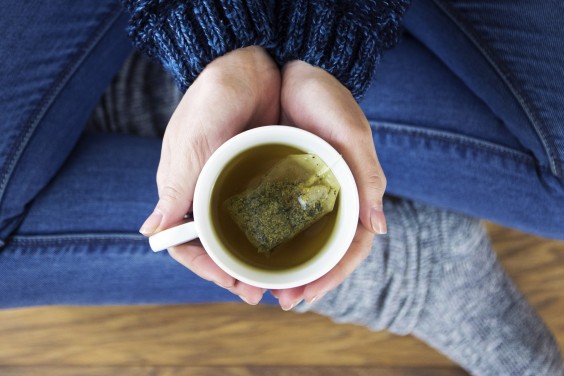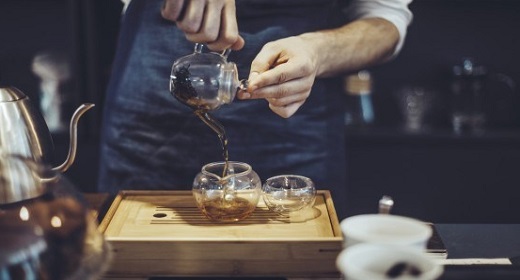by Lindsey Engkelken: There are really no downsides to getting into tea…
it’s generally pretty healthy and can be lower in caffeine and better on your wallet than other drinks. But it can be confusing. Too many options, you know?
So we’ll make it simple. Despite the thousands of flavors and varieties, all tea falls into one of five families: black, green, oolong, white, or dark. (Herbal doesn’t make the list because it’s not technically tea—for something to count, it needs to come from the plant Camellia sinensis, and herbal “teas” don’t.)
All tea is from the same plant, but there’s still a wide variety of color and taste between each family. The differences come from the part of the plant used, the topography and climate of the area in which the plant is grown, and the way it’s processed. And pro tip: Black tea doesn’t automatically have more caffeine than other varieties—caffeine levels mostly come down to how much the leaves are cut up in your tea bag (smaller pieces = more caffeine) and how long the tea is brewed.
Got all that? Good. Here’s what you need to know about common teas in each family before flipping on the kettle.
Black Teas
Black teas are typically bold and severe, as they have more tannins (a compound also common in red wine that gives you that weird dry feeling in your mouth) than other tea families. They also have a longer oxidation process than most tea—the leaves are cut up or rolled to release their natural oils, left to react with the air for several hours, then roasted to stop oxidation and dry them out.
Black tea is the most common category, so some of these varieties might sound familiar:
Assam
Named after the region where it’s grown in India, Assam tea has a unique malty flavor. It’s typically used as the base of Chai tea, but it’s also sold as a breakfast tea and is often added to breakfast blends such as Irish breakfast and English breakfast.
Ceylon
All Ceylon tea is grown in Sri Lanka, but depending on which part of the country, it can have flavors ranging from chocolate to citrus. Ceylon tends to be spicy, and it’s usually the main tea in Earl Grey and fruity blends.
Earl Grey
Technically speaking, Earl Grey isn’t a variety of tea at all. It’s mostly Ceylon tea, but the use of bergamot changes the flavor into an aromatic blend of floral, sweet, woodsy, and sour.
Lapsang Souchong
This one’s for the whiskey lovers. Lapsang souchong has orange, floral, and vanilla notes with a smokey flavor—probably because it’s dried on an open fire over pine wood.
Darjeeling
Darjeelings are delicate and the flavor can vary widely from brand to brand, or even within the brand itself. In this case, it depends on when the tea was grown—there are three different growing seasons in the Darjeeling region of India, and each provides a distinct flavor. Here’s a rundown:First Flush Darjeeling: Picked in spring, First Flush has appropriately fresh and floral flavors. It’s sometimes called the “champagne of Darjeeling.”Second Flush Darjeeling: Second Flush has a strong, rich flavor that tastes similar to grapes. It’s harvested in summer.Third Flush Darjeeling: Coppery in color and sweet in taste, Third Flush is mellow, floral, and smooth. It’s picked in autumn.

Green Teas
Unlike black tea, green tea is unoxidized, which means the oils in the leaves never react with the air and it gets to keep its green hue. As a whole, green teas are usually sweeter and mellower than black teas, but it does depend a little on how it was processed. In Japan, for example, green teas are usually flash-steamed to prevent oxidation, but Chinese green teas are dry roasted instead. This results in a different flavor and brewing process.
Sencha
The most popular tea in Japan, sencha is briefly steamed before drying. This process gives it a grassy flavor and a bright green hue. Interestingly, some people say they taste a little seafood or seaweed flavor too.
Bancha
Harvested later in the season but processed in the same way as sencha, bancha is more earthy than grassy. Though it has a sweet, robust flavor, it’s typically less aromatic than sencha is.
Hojicha
If you’re a die-hard coffee drinker trying to convert, hojicha is your brew. The roasting process brings out nutty, toasty, and caramelly flavors reminiscent of coffee, and with a reddish-brown color, it almost looks like coffee, too. Almost.
Gunpowder
A Chinese tea that’s rolled into a pellet shape, gunpowder is named for its resemblance to grains of gunpowder. Its flavors are appropriately smokey and peppery, with a touch of honey spice (without the sweetness).
Chun Mee
Chun mee literally translates to “precious eyebrows,” which is probably a reference to the arched shape of the leaves. It’s sourer than most green teas, and it has a plum-like aroma and aftertaste that sets it apart.
Oolong Teas
The process of making oolong tea combines the process of making black tea and green tea, and the flavors reflect this. Oolongs are partially oxidized before they’re roasted, and depending on how long they’re left to react with the air, oolong can taste anywhere from floral and fruity to earthy and nutty to grassy and spicy. No matter the flavor, though, oolongs tend to be fuller-bodied than black teas.
Dark Teas
Dark teas are processed almost exactly like green teas, but instead of being roasted, dark tea leaves are fermented. This aging process results in a sweeter and less tannic flavor that changes over time. Puer tea, for example, is floral and grassy when it’s young, but becomes woodsy and minty with a fuller body if it’s left to age for more than seven years.
White Teas
Because they’re neither oxidized nor roasted, white teas are the sweetest and most delicate of the tea varieties. They tend to be light and floral, though some are slightly nutty too.


















































